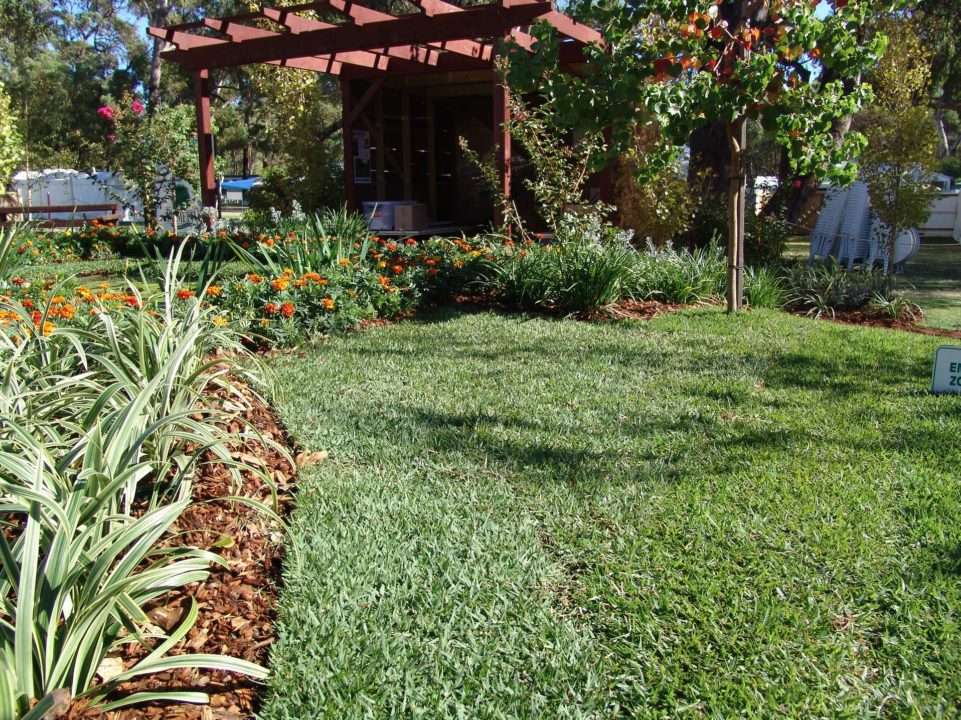
With the first day of spring approaching, warmer weather signals plants to come out of dormancy and start flourishing again. The time for spring lawn care tips is right around the corner! Even if your lawn and garden never went fully dormant, you can still expect your home landscape to begin thriving with warmer temperatures.
Pretty soon, your lawn and garden will be full of color and activity again! If you have a warm season lawn, your turfgrass will come out of dormancy and if you have a cool season lawn, snow in your area will start to melt and you’ll enjoy a greener environment.
Youtube video link: https://youtu.be/ErmL0TMpNys
1. Begin Mowing Your Lawn at the Proper Height Again:
The timing for which the first mow of the spring for your mature, established turfgrass widely varies depending on the area you live in. Grasses come out of dormancy differently depending on the environment and temperatures your area encounters.
For example, if you live in South Florida, your grass may have never entered dormancy at all during the winter. Many homeowners who live in South Florida will mow their lawn every other week during the winter—oftentimes starting in September and resuming a regular, weekly mowing schedule again in mid-March.
Generally speaking, however, mid-March is about the time for you to begin your regimen for spring green-up and mowing. It’s important to note that the first mow of the spring shouldn’t take place while warm season grass is dormant.
Mowing heights vary for each grass type, but you should never remove more than a third of the leaf blade from any grass type. If you mow less than this, you may risk scalping the grass. To find out which mowing height your specific grass type should be maintained at, view our Lawn Mowing Guide.
Lastly, a good tip for spring is to make sure your lawn mower blades are sharpened so that the mower blades neatly slice through the grass in place of ripping them. If the grass blades aren’t cut neatly, the mower is ripping them and opens the grass up to the possibility of disease. Performing regular maintenance on your mower is good practice for the end of the mowing season or before spring takes place.
2. Start Your Lawn Off Right with the Appropriate Spring Fertilizer This Year:
Spring is one of the most important times of the year to use fertilizer. Warm season grasses are coming out of dormancy, so you will want to promote healthy roots and the return of green leaf blades.
Be careful when making your first fertilizer application of the year though—a lot of homeowners see their grass green up and immediately pull out the fertilizer and lawn mower. We advise that you typically wait until the last frost has hit.
If you fertilize your lawn and another frost hits, your grass will go right back into dormancy, and you’ll have a harder time getting it to green up again. This does more harm than good.
With that being said, the date of the last frost varies from location to location. In the Florida Panhandle, for example, grass doesn’t ever go truly dormant and reaches its full green-up in early February (depending on how cold the winter was).
Even then, you won’t want to apply fertilizer until after Easter once the last frost has passed.
Sod University recommends two different options for spring fertilization: Lawnifi® Foundation, a slow-release granular option that comes in 25 lb. bags and lasts for three months, and our Lawnifi Spring Fertilizer Box, a liquid fertilizer program that includes three bottles of liquid fertilizer that can be applied monthly with a hose-end sprayer.
Each option covers 5,000 sq. ft. Our patented nano-fertilizers with Catalyst TechnologyTM give your lawn the jump-start it needs to emerge from dormancy, green up fast and thrive throughout the spring months.
Check out Why Use Lawnifi Fertilizer? for more information about Lawnifi.
Next, it is important to mention that if you have a warm season lawn, you may start to notice spots of brown or straw-like grass while the rest of your lawn comes out of dormancy. This is usually a sign of disease.
You do not want to apply fertilizer to a lawn with disease as the nitrogen in the fertilizer will feed the disease and promote its growth. Apply a systemic fungicide first and then wait several weeks before following with a fertilizer application.
3. Set Up a Spring Irrigation Schedule:
Dormant, warm season turfgrass doesn’t need much water until the active growing season kicks in and your grass starts to green up. If you have a dormant, warm season lawn, it is not dead—it’s just “sleeping”.
Although dormant grass requires much less water than it would while it is actively growing, it will still need water. Once your grass starts to green up from winter dormancy, you should resume watering your lawn with about 1 inch of water per week including rainfall.
If you aren’t sure how to measure how much water your lawn is receiving, an irrigation audit may be beneficial to you. Irrigation audits provide measurable information about how much water each area of your lawn is receiving within a given amount of time.
If you’re a homeowner who lives far enough south and your warm season grass doesn’t go dormant during the winter, you may continue to regularly water your lawn in the winter.
However, if you live in South Florida, for example, you may turn your irrigation off completely during the winter and during the months of June–August when it rains a lot.
The atmosphere in South Florida isn’t usually evaporating much water and the grass isn’t using it much during the winter, so frequent irrigation isn’t needed.
The next few tips in this article discuss spring lawn treatment with fungicides, herbicides or insecticides. If any of these control products or fertilizers are granular, you will need to water the product in so that your lawn absorbs it.
When watering granular products in, you will already be watering your lawn with the appropriate amount of water during the week of application.
The same can be said with any liquid products as they are either products that attach to the end of your garden hose or require tank mixing with water.
Above all, read and follow label instructions thoroughly before watering any products in.
4. Control Weeds with a Pre- or Post-Emergent Herbicide:
Pre-emergents should be applied during the spring when ground temperatures reach about 55 degrees Fahrenheit. A pre-emergent herbicide functions to prevent weeds from emerging from the surface of the soil, as its name suggests.
The exact dates for these applications differ depending on the area you live in, but generally speaking, pre-emergents should be applied between the beginning and middle of March in the spring.
Apply post-emergent herbicides throughout the spring as needed to control summer annual and perennial broadleaf weeds like crabgrass, goosegrass, sandspurs, dallisgrass, dandelion, chickweed, white clover, knotweed, spurge, dollarweed, doveweed and lespedeza.
5. Watch Out for Insects That May Begin Coming Out:
If your lawn has suffered from insect damage around this time in the past, it is a good idea to apply a broad spectrum insecticide at this time to prevent them from coming back again.
If the insecticide is a granular product, be sure to water it in so that it soaks into your soil. On the other hand, if it’s a liquid product, you will either need to attach it to the end of your garden hose or tank mix it.
Some of the most common of insects in the springtime are white grub worms, chinch bugs, sod webworms and billbugs. White grub worms can be found in most turfgrasses at this time while chinch bugs are more likely to be spotted in St. Augustine grass, sod webworms in bermuda grass and billbugs in zoysia grass.
Sod webworms are typically more of a summer or fall pest, however, they can still cause a significant and costly nuisance to lawns located throughout the Southern regions of the U.S. during the spring season.
6. Prevent Disease as Temperatures Begin to Warm Up:
As previously mentioned, if you have a warm season lawn, circular brown or yellow spots, also known as spring dead spot, may start to show up as it comes out of dormancy.
Other potential disease outbreaks include brown patch and gray leaf spot. If you notice any disease outbreaks, you may need to make applications of a systemic fungicide. Even if you don’t have disease in your lawn, it’s still good practice to apply it preventively to keep disease from taking over—especially if you’ve had disease in the past around this time.
Systemic fungicide applications should take place before you apply any spring fertilizer. If you have fungus in your lawn, the nitrogen found in fertilizers oftentimes feeds it and helps it spread. Apply a systemic fungicide and wait a few weeks before applying any fertilizer.
Read product labels thoroughly.
There are a few other optional things that can be done to help your lawn thrive in the spring.
Before the onset of summer heat, lawn patchwork and light top dressing with a sand and topsoil mix is a great way to recover any weak areas. Plugs can be purchased to fill in areas of the lawn with bare spots.
Aerating your lawn is also an ideal way to help deliver nutrients and really break up compacted soils. We typically recommend doing this once every couple of years. If you notice thatch that is thicker than 1⁄2 inch, dethatch in late May.
Spring maintenance tips somewhat differ from maintenance practices that take place during the rest of the year because the weather is starting to warm up and everything starts to turn green again. Although cool season grass doesn’t usually go dormant during the winters, snow in a lot of the areas up north starts to melt and your lawn will receive more sunlight. It is important to partake in spring maintenance so that you can set your lawn up for success for the rest of the year.





